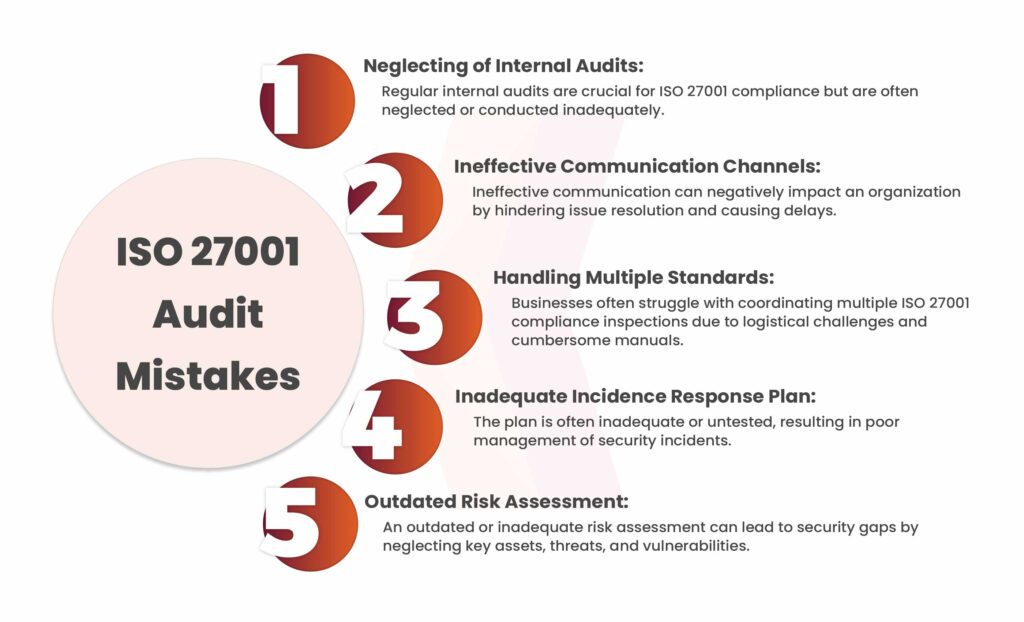
2024-10-25 15:42:9 Author: securityboulevard.com(查看原文) 阅读量:1 收藏
ISO 27001 audit can be a challenging yet rewarding journey for any organization. This international standard outlines the requirements for an Information Security Management System (ISMS), enabling organizations to protect their sensitive information. However, many businesses encounter common pitfalls during implementation that can impede their progress and effectiveness.
One significant issue is neglecting the vital role of support from top management. Without the commitment of senior leaders, the necessary processes and resources for achieving ISO 27001 compliance may be insufficient. Another frequent mistake is performing inadequate risk assessments. Comprehensive risk assessments are essential for identifying potential security threats and effectively addressing them.
Mistakes to Avoid During ISO 27001 Audit
ISO certification represents an organization’s dedication to quality and compliance. However, the journey to obtaining this certification can be difficult, and many companies struggle to meet the rigorous criteria set for ISO audits. Below are the mistakes to avoid during ISO 27001 audit:

Neglecting Internal Audits
Regular internal audits are essential for maintaining ISO 27001 compliance, but they are frequently overlooked or poorly executed. To tackle this issue, organizations should implement a structured, ticket-driven internal audit process. Audits should be scheduled regularly and conducted by qualified, impartial auditors. These audits offer valuable insights into the effectiveness of the controls in place and help pinpoint areas for improvement.
Ineffective Communication Channels
Ineffective communication can have a cascading impact on an organization. For instance, if a company lacks clear communication channels, it can hinder an auditor or shop floor worker from addressing issues and initiating resolutions, leading to delays and further deviations that require additional communication.
Digital quality audit software offers three ways to automate the sharing of real-time information with relevant stakeholders and establish clear communication channels:
- Auditors can generate detailed inspection reports that can be emailed to the appropriate parties with a single click.
- Task assignees receive notifications about the tasks assigned to them.
- Managers can track task status in real-time.
Handling Multiple Standards
Businesses frequently face the challenge of complying with multiple ISO 27001 compliance and other standards. Coordinating inspections for all these standards at once can lead to logistical difficulties, especially if auditors are burdened with a pile of manuals.
By using audit software, you can create, update, and store customized ISO 27001 audit checklists on a centralized platform. When scheduling an audit, you can select and assign the necessary checklist, which auditors can easily access on their mobile or tablet devices during the inspection. This centralized method removes the need for physical manuals and ensures that auditors have the most current information at their fingertips.
Inadequate Incident Response Plan
Incident response plans often prove to be insufficient or untested, leading to ineffective management of security incidents. To ensure their effectiveness, it is essential to regularly test and update these plans. Organizations should adopt a ticket-driven approach, consistently reviewing and simulating different incident scenarios to uncover vulnerabilities and enhance their response capabilities.
Outdated Risk Assessments
An outdated or insufficient risk assessment overlooks critical assets, threats, vulnerabilities, and impacts, which can result in security gaps. To address this, it is essential to regularly update and maintain a thorough, comprehensive risk assessment process. This enables organizations to identify new risks, adjust security strategies, and effectively mitigate potential threats.
How Can Organizations Avoid Mistakes During ISO 27001 Audit?
To implement ISO 27001 compliance successfully, it’s essential to follow a detailed checklist to stay on course. Here are some key measures to include:
Establish the Scope
Which areas of your organization will be included in the ISO 27001 certification? Identify the information assets and business processes to be covered, outline any exclusions, and obtain management approval.
Perform Risk Assessment
The next step is to conduct a comprehensive risk assessment. Follow these steps to identify and evaluate the risks your organization faces:
- Develop and document a risk management framework to ensure consistency.
- Identify scenarios where information, systems, or services could be compromised.
- Assess the likelihood or frequency of these scenarios occurring.
- Analyze the potential impact of each scenario on the confidentiality, integrity, or availability of your data, systems, and services.
- Prioritize risk scenarios based on their overall impact on the organization’s objectives.
Implement ISMS Policies and Controls
After completing the Statement of Applicability and initial risk assessment, you should have a clear plan for advancing ISO 27001 compliance. Follow these steps to address each control listed in your Statement of Applicability:
- Assign responsible owners for each security control to be implemented.
- Establish a method to track the progress and goals for each control.
- Develop a framework to establish, implement, maintain, and continually improve the ISMS.
Perform ISO 27001 Internal Audit
To ensure a successful official audit, conduct an internal audit to address any areas of non-compliance. Complete the following tasks during your internal review:
- Review each requirement from Annex A that is applicable in your ISMS’ Statement of Applicability and confirm they are implemented.
- Assign internal employees who were not involved in ISMS development or maintenance, or hire an independent third party to perform the audit.
- Share the internal audit findings, including any non-conformities, with the ISMS team and senior management.
- Resolve any issues identified during the internal audit before moving forward with the external audit.
- Verify compliance with the applicable Annex A requirements from your ISMS Statement of Applicability.
Book a Free Consultation with our Cyber Security Experts

How can Kratikal Help you With ISO 27001 Compliance?
As a CERT-In empanelled auditor, Kratikal has the expertise to help businesses comply with ISO/IEC 27001:2022 and strengthen their cybersecurity posture. Our services can assist you with:
- Kratikal carries out in-depth analyses to determine whether your company is prepared to comply with ISO/IEC 27001:2022.
- Analyze your present information security framework for gaps and vulnerabilities to provide a roadmap for improvement.
- Help in developing policies and processes for information security in accordance with ISO/IEC 27001:2022 standards.
- To lessen security threats associated with people, provide employees with security awareness training.
- Your ability to recognize and respond to malware will increase if you incorporate threat intelligence into your security strategy.
- Create and enhance incident response plans to address malware issues and other security-related issues.
FAQs
- What is ISO 27001 audit criteria?
An ISO 27001 audit entails an impartial auditor to review the ISMS or its components to ensure they meet the standard’s requirements. The audit also verifies that the organization’s information needs and ISMS objectives are met and that its policies, processes, and controls are effective and practical.
- Who performs ISO 27001 audits?
Only ISO 27001-certified auditors, affiliated with a certification body, are qualified to assess your ISMS for external audits. To become certified, they must complete a required number of audits and hours of training. The certification body is ultimately responsible for issuing the final certification.
- Can you fail an ISO 27001 audit?
Many businesses struggle to pass an ISO 27001 audit or a surveillance audit for various reasons, including missing, unpublished, or outdated information.
- What type of audit is ISO 27001?
The ISO 27001 certification process involves various types of audits, such as internal and external audits, all of which should be managed through an audit program and an audit plan. The lead auditor is tasked with creating the audit plan. Internal audits encompass both formal internal audits and management reviews.
The post Common Mistakes to Avoid During ISO 27001 Audit appeared first on Kratikal Blogs.
*** This is a Security Bloggers Network syndicated blog from Kratikal Blogs authored by Shikha Dhingra. Read the original post at: https://kratikal.com/blog/common-mistakes-to-avoid-during-iso-27001-audit/
如有侵权请联系:admin#unsafe.sh

